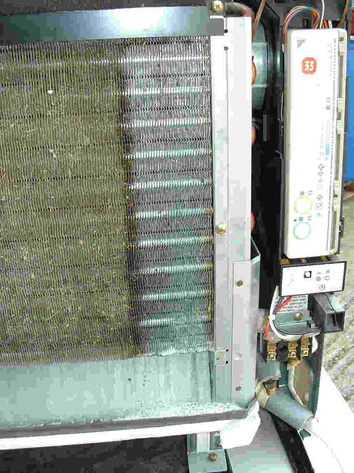31 March 2016
|
In Part Two of this step-by-step guide on how to perform the perfect service of an outdoor air conditioning unit, AC&R service and maintenance experts Advanced Engineering look at servicing and cleaning methods, corrosion protection, external leak checks, security considerations and important final checks, visual inspections and documentation procedures. (Read Part One)
PART TWO
In Part One of Advanced Engineering’s guide to the perfect service of an external air conditioning unit, we looked at initial visual inspections, general housekeeping and internal maintenance and leak checks. Now the focus switches to the heat exchanger and external leak checks.
Content continues after advertisements
Cleaning the heat exchanger
| Dirt that accumulates on the coils comes from airborne particles, insects, leaves, etc. which in conjunction with the high temperature of the coil can become ‘baked’ on and prove very difficult to remove unless you’re using the right cleaner. So called “mechanical cleaning” using a brush or other tool is a good first step, but to clean the coil thoroughly you should consider a chemical cleaner. They cost pennies and the difference compared to mechanical cleaning can be profound, especially when it comes to maximising the unit’s efficiency and extending the period between services. While there are products available that are environmentally friendly, for stubborn deposits you may wish to use a heavier duty solution like SuperClean. |
Apply a protective coating to ensure long term corrosion protection

This is a simple step that’s easy to do and can save you a great deal of time, effort and money in the long run. Use a good protective spray like EasyCoat, which is an acrylic protective coating for coils that has an indicator dye so you can ensure complete coverage. It dries quickly so this shouldn’t take long.
This is particularly important if the unit is near the sea. Due to the high levels of salt in the air in these environments, the aluminium fins can become corroded very quickly which will affect the unit’s ability for effective heat transfer.
This is particularly important if the unit is near the sea. Due to the high levels of salt in the air in these environments, the aluminium fins can become corroded very quickly which will affect the unit’s ability for effective heat transfer.
External leak checking
Replace face panels
| When replacing the facia panels ensure the casing fits correctly and snugly. Turn the unit back on at the isolator to make sure it functions appropriately. You then want to check for vibrations, so operate the unit and force it to come on cooling; ramp the heating up to check this. Listen and look at the unit to check it sounds as it should, and ensure the compressor or fan is not vibrating on bouncing on its brackets. |
Final checks
| Now it’s time to ensure all sealing caps on connections to the refrigeration system are replaced. There will be two connections, one on the high side and one on the low side (they have valves on them and plastic caps). Engineers can use existing caps unless they’re worn or have deteriorated, but it is a good idea to invest in tamper-resistant security caps. Spanner-operated security caps prevent a member of the public from opening and venting the unit maliciously (like a car or bike tyre), and they also act as an extra level of security if the valve fails. |
Visual check and completion of the F Gas Label
And finally, check the panel and complete the F Gas label, documenting the service and any leak checks. It is also a good idea at this point to perform a leak check of pipework with the system running.
Focus on flared joints, as these are mechanical connections, and braised joints (again, you may need to move insulation out of the way). Engineers should also detail the weight and gas in the system on the F Gas label.
Before you leave, simply clean the fascia and case, remove any grease, fingerprints or grime using with a finishing case cleaner like EasyFinish.
Focus on flared joints, as these are mechanical connections, and braised joints (again, you may need to move insulation out of the way). Engineers should also detail the weight and gas in the system on the F Gas label.
Before you leave, simply clean the fascia and case, remove any grease, fingerprints or grime using with a finishing case cleaner like EasyFinish.
If you would like specific advice on maintenance and servicing techniques or products, contact the experts at Advanced Engineering on their support hotline: +44 (0) 1256 460 300 or visit their website advancedengineering.co.uk or YouTube channel for more cleaning tips and guidance.













